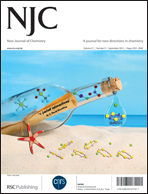Electrical and thermoelectric attributes of Ba2Co2Fe12−2x(Ti–Mn)xO22 and their catalytic activity for complete N2O decomposition
Abstract
A series of Ti–Mn co-doped Ba2Co2Fe12−2x(Ti–Mn)xO22 (x = 0.2–1.0) Y type hexaferrites has been synthesized by sol–gel method. Single phase hexagonal crystal structure was confirmed by


 Please wait while we load your content...
Please wait while we load your content...